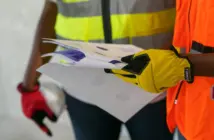For solo farmer Peter Phillips, repeatedly suffering a ‘crook back’ from lifting ewes during lambing was a major and painful inconvenience – until he found the perfect solution
Installing a second-hand wheelchair lift on the back of his ute now enables him to lift and move animals and other heavy loads without getting injured – and avoid downtime during his busiest time of the year.
“A crook back would regularly put me out of action for two or three days and that’s the last thing you want during lambing,” said Peter, who farms beef and sheep on irrigated flats, rolling terraces and steep hill land at Tapawera, 30 km from Nelson.
“I’ve been farming for 54 years, since I was 15, and for maybe 20 years I’d been suffering back injuries from lifting. I got to the point when I just couldn’t do it any more.”
The 270-hectare farm is divided into two blocks. Peter has a manager on hill land in the Tadmor Valley while he farms the home block at Glenrae.
He used to grow potatoes and farm budget cows, with one worker. However, in recent years he has moved to beef and lamb, farming alone.
Initially, he considered getting a tail lift for his ute to address the challenges of lifting. However, when he went along to a supplier they suggested a wheelchair lift would be more suitable.
He made some inquiries and found second hand ones with electric hydraulic systems are pretty easy to come by.
“I bought it from an auto repair and restoration service in Nelson and my local garage fitted it to my ute.
They just bolted it onto the left side of the deck and it doesn’t interfere with the deck space at all.
“I tie the ewes’ legs and then I can just roll them onto the lift. I get on with them, press a button and up we go. I have a half crate on the deck so they can stand up in that. They’re happy and I’m happy.
“It is a marvellous thing. I’ve used it through two lambing seasons now without hurting my back. I also use it for firewood. I can roll a great circle of wood onto it and take it to my shed and when the weather’s bad I get in there and split it.
“At times of the year when I don’t need lifting equipment then it can just be unbolted from the ute. It’s been a simple answer to a big problem and I’d recommend it to any farmer as a way of looking after your back. It’s been a simple answer to a big problem and I’d recommend it to any farmer as a way of looking after your back.”
WorkSafe Agriculture Sector Lead Al McCone says that this sort of innovation, where farmers are looking for ways to reduce wear and tear on their back and joints, is essential to bring down the overall injury rate among farmers. “I strongly encourage farmers to share these sorts of ideas.”
PREVENTING INJURIES FROM MANUAL HANDLING
Farm workers do a variety of manual handling tasks. These involve using force, repetitive movements, stooping, static and awkward postures, continual bending and twisting at the waist, and handling heavy objects.
There are several ways to identify manual handling hazards on the farm:
- Farm records (eg hazard registers, accident investigation forms, early report of discomfort) are a good source of information to identify manual handling tasks where people were harmed from manual handling tasks.
- Talk with employees who can help you understand potentially unsafe tasks.
- Watch all manual handling tasks to identify the hazards and assess the risk level each task poses.
- Make sure your workers know which manual handling tasks are hazardous and how they can reduce injury risks.
- Plan for appropriate handling of heavy objects.
KEY POINTS
- Manual handling can harm your musculoskeletal system (bones and muscles), slowly, so the injury gets worse (chronic) over time.Prevention is the best approach.
- Identify the manual hazards on the farm and put steps in place to minimise handling injuries.


